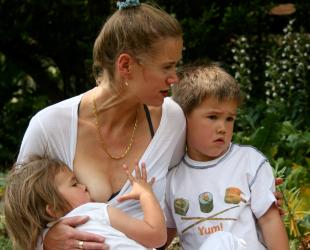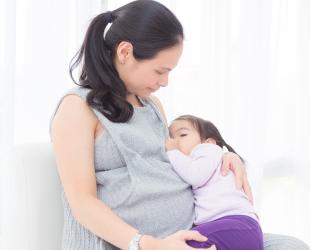Wondering how breastfeeding affects fertility? Read on for answers

Whether you're planning for another baby, or hoping to avoid pregnancy, here's what you need to know about breastfeeding and your fertility.
How does breastfeeding affect fertility?
If you're not breastfeeding, you might ovulate as early as 5 to 6 weeks after birth.
Breastfeeding delays the return of your hormones to pre-pregnancy levels, which can delay ovulation and your periods.
Every mum is different—some get their periods back within months, others after a year or more. It can depend on your baby’s breastfeeding pattern and how your body responds to breastfeeding hormones.
Your periods can return when your baby starts to breastfeed less or for shorter times. This might happen if:
- your baby sleeps for longer stretches or through the night.
- you start offering formula top-ups.
- they start solids.
When your period returns, it might not be regular at first. Even after periods return, breastfeeding mums often have fewer regular cycles and are less likely to get pregnant in the first year after birth.
Tip: Any change in vaginal mucus or bleeding could signal a change in your hormone levels and a return to fertility. Unless you know your ovulation signs very well, you may not know you're fertile again until your first period.
Do I have to stop breastfeeding to get pregnant?
If your periods have returned and you're ovulating, you may not need to wean to get pregnant. You can check for ovulation using a temperature chart, cervical mucus changes or a home ovulation test.
If you have trouble ovulating, or the second half of your menstrual cycle isn't long enough to begin a pregnancy, you might need to wean for the best chance of success.
Some mums need to fully wean before ovulation returns.
If you will need to use IVF treatment, deciding whether to wean can be tough. Some parents choose to wean to boost their chances of success, while others wait until their child is a little older.
Birth control choices
Most couples start thinking about birth control soon after their baby is born. Breastfeeding mums have several options, but no method is 100% effective. Talk to your doctor or family planning organisation before deciding.
The Lactational Amenorrhea Method (LAM)
LAM is a 98% effective method of contraception if you meet all these conditions:
Your periods haven't returned.
AND your baby is less than 6 months old.
AND you are exclusively (fully) breastfeeding (no other foods or drinks) including during the night.
Non-hormonal birth control methods
These can be a good choice as they’re safe to use when breastfeeding.
- Condoms (use water-based lubricant if needed)
- Copper IUD
- Diaphragm
- Ovulation awareness methods, like the Billings Method.
Hormonal birth control methods
- Progesterone-only methods (minipill, progestogen IUD, injections, implants) are commonly used by breastfeeding mums. Some notice a drop in milk supply, especially if started while their baby is very young. Feeding more often can help, but sometimes switching to a non-hormonal method is needed.
- Combined contraceptive pill can be used after 6 weeks, but some mums still notice reduced milk supply.
- Emergency contraception is usually safe for breastfeeding and can be taken up to 72 hours after sex.
Talk to your doctor or pharmacist if you have questions about the safety or suitability of different hormonal birth control options while breastfeeding. You can also call a medicines information line for advice.
The information on this website does not replace advice from your healthcare provider.
© Australian Breastfeeding Association November 2025
Evidence-led info and practical tips from our Parenting Information Series
Breastfeeding: diet, sex, exercise and more



